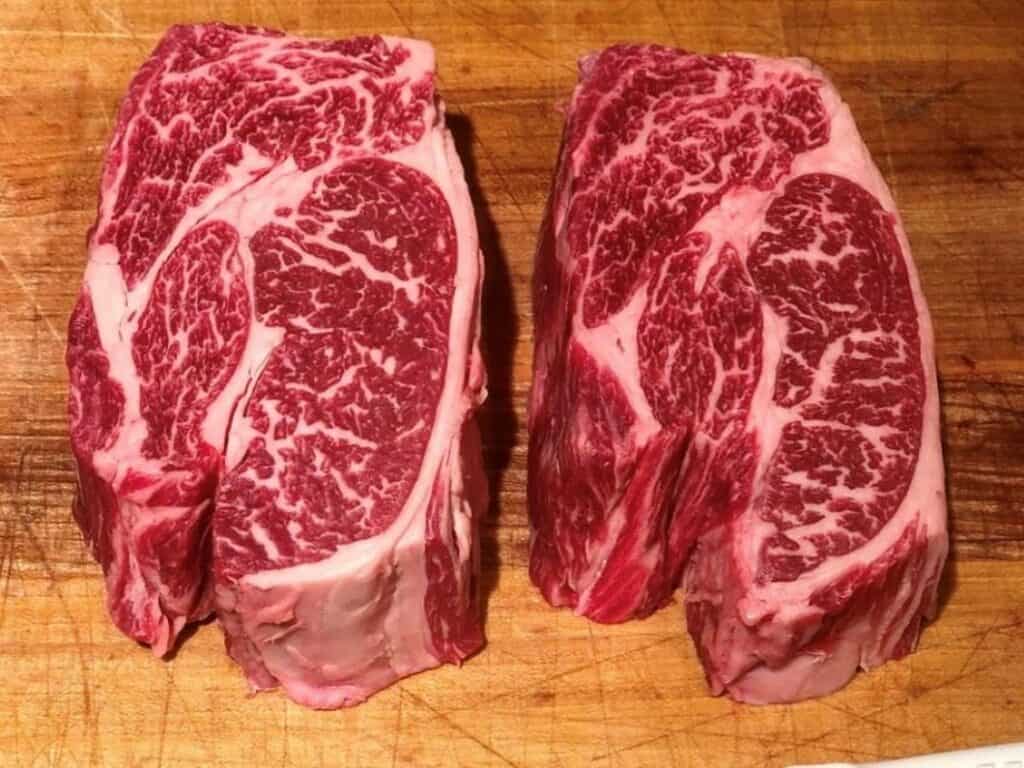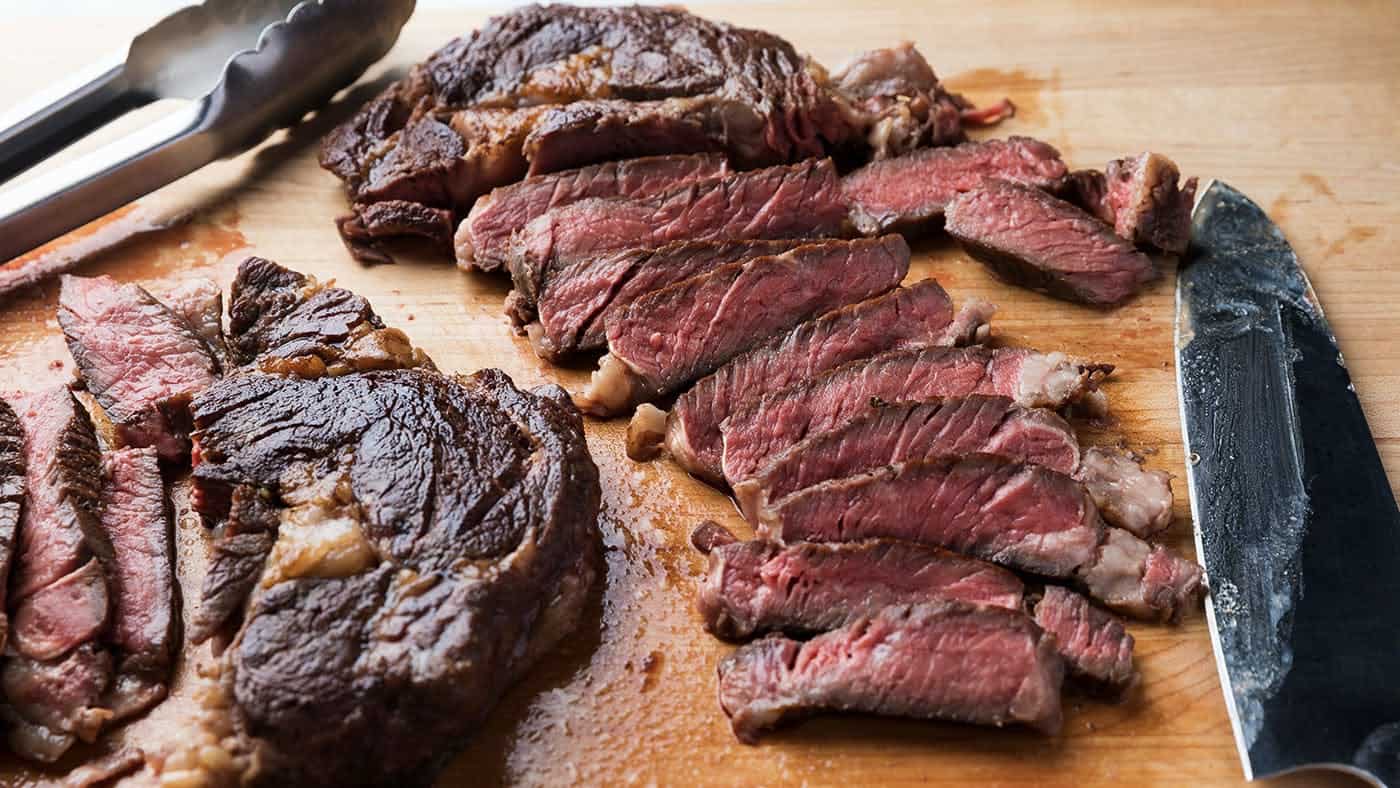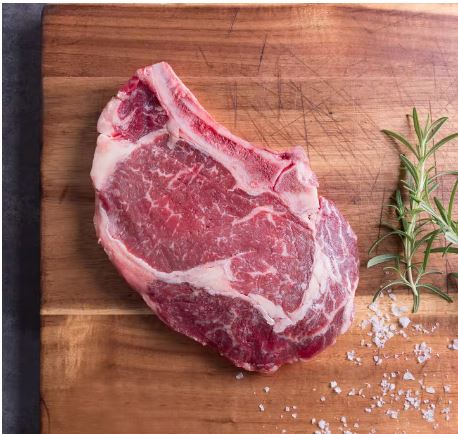- US Wellness Meats Review: What You Should Know Before Buying - April 12, 2023
- Smoked Chuck Roast vs Brisket: Which Cut Is Better Quality? - September 22, 2022
- Porterhouse vs Ribeye: Which Steak Wins? - July 25, 2022
Not to blow our own trumpets here, but we know a thing or two about steak. Whether they’ve been grilled, broiled, boiled, or smoked, it’s all fair game for us.
And it’s not just the mainstays of the steakhouse that we cover, like the sirloin and the T-bone steak – we also know a thing or two about those lesser-known steaks like the picanha, the tri-tip, and the tomahawk steak.
To add to that roster of potentially less well-known steaks, we have the chuck eye, which we’re going to put up against the ribeye in an epic chuck eye vs. ribeye battle. So without further ado, let’s dive into this steak showdown and find out which one you should choose out of chuck eye vs ribeye.
First of all, let’s have a look at the main differences between chuck eye vs ribeye.
Main Differences between Chuck Eye vs Ribeye
The Main Differences Between Chuck Eye and Ribeye are:
- Chuck eye is taken from the 5th rib of the animal, whereas ribeye is taken from the 6th-12th ribs.
- Ribeye is easy to find in nearly any supermarket or restaurant, whereas chuck eye is usually only found in butcher shops.
- Chuck eye is a great cut for a slower cook, whereas ribeye can be easily cooked.
- Ribeye can be bought bone-in, whereas chuck eye is often purchased without the bone.
- Chuck eye is a little bit tough, whereas ribeye is often beautifully tender.
- Ribeye is usually a little bit more expensive to get your hands on, whereas chuck eye is cheaper.
If you are familiar with Flat Iron Steaks and love a rich, beefy flavor, then these Chuck Eye Steaks are for you. Get yours at US Wellness Meat as their beef products are 100% grass-fed and grass-finished.
What Chuck Eye Steak? The Poor Man’s Ribeye
The chuck eye is quite often called the ‘poor man’s ribeye’, as it’s from the same area as the ribeye – just a bit further into the shoulder, or ‘chuck’, of the beef. It’s sometimes known as the Delmonico steak too.
They’ve got the same great flavor of a ribeye, but aren’t quite as tender – however they taste stunning whether you grill yours or broil it. However you like to cook your steak, the chuck eye will deliver bountiful flavor.
What does a Chuck Eye look like?

If you had a chuck eye next to a ribeye you’d be hard-pressed to tell the difference between them! After all, the ribeye is often cut from the 6th to the 12th ribs, whereas the chuck eye is taken from the 5th rib. So not too different after all!
This means that, like the ribeye, the chuck eye has some glorious intramuscular marbling throughout it, along with a nice slice of fat on one edge – culminating in the iconic ‘eye’ shape formed by the fat!
What does a Chuck Eye Steak taste like?
As you’re getting a very similar, if not identical, cut to the ribeye, you can expect those gorgeous, beefy, buttery flavors that the ribeye is renowned for. However, it’s worth noting that because the chuck eye comes from the 5th rib, it’s a muscle area that gets a bit more use than the ribs that ribeye steak comes from.
This makes the chuck eye slightly tougher than the ribeye – but if you know your way around your meat, then you’ll know that this slight issue can be resolved pretty easily by how you go about cooking it.
How much does a Chuck Eye cost?
Butchers across the country will shake their fists at us for spilling the beans about this often misunderstood and ignored cut of meat – because quite often, the butchers will claim this cut for themselves! Also, one animal can only produce 2 chuck eye steaks, meaning that it can be quite a tricky one to find.
Despite these hurdles that we’re sure you’ll overcome, the main attraction for the chuck eye is the price. You’ll often end up paying $4-$6 less per lb than you would for the same amount of ribeye – what’s not to love! This means you’ll be paying around $9 per lb. We wouldn’t be surprised if you were already on the way to the butcher’s shop!
If you are familiar with Flat Iron Steaks and love a rich, beefy flavor, then these Chuck Eye Steaks are for you. Get yours at US Wellness Meat as their beef products are 100% grass-fed and grass-finished.
How do you cook a Chuck Eye?

While you may have already checked out and taken notes on the principles of grilling, we would recommend a different method for cooking the chuck eye. The method we recommend is called sous vide, and it’s becoming rather popular with amateur chefs across the country.
Effectively it involves immersing the steak in a bath of temperature-controlled water and cooking it for a while. Now, this might sound a little scary to take the plunge, but you can get your hands on this great Sous Vide Starter Kit that has everything you could need to get started. If you’re ready to dive in, follow our guide to cooking chuck eye with sous vide!
Create perfectly cooked meals with our superior precision-controlled Sous Vide immersion circulator that delivers incredibly tasty, juicy results without overcooking.
- Fill a large pan with water, leaving some room at the top so that it doesn’t overflow.
- Season your chuck eye steak with plenty of salt and pepper.
- Place your chuck eye steak in a vacuum bag, or just a plain old Ziploc bag will do – make sure it’s watertight and try and get as much air out of it as possible.
- Let your water slowly come to a steady temperature, and then increase the temperature incrementally. If you want a medium-rare, bring the water up to 138oF. You can use a meat thermometer for this – we like to use the BFOUR meat thermometer.
- Add your steak, making sure that the bag doesn’t touch the bottom of the pan, and leave it to cook for 1 hour.
- Once it’s been in for an hour, take it out of the water and leave it to cool slightly for 5 minutes. Heat up a large skillet with a splash of oil in the meantime.
- Take the chuck eye out of the bag and sear it in the pan for 1 minute on each side.
- Leave the chuck eye to rest for 10 minutes or so before serving up your beautifully tender and flavorful treat!
The wireless meat thermometer adopts the most advanced Bluetooth 5.0 that provides the strongest, reliable connection, allowing you to monitor meat up to 200ft away.
Is Chuck Eye Steak Tough?
The short answer is that chuck eye steak should not be tough if you’ve cooked it correctly.
The longer answer is that compared to other steaks like the ribeye, chuck steak is a little bit tougher, even when properly prepared.
What is Ribeye Steak?
The ribeye steak surely needs little to no introduction. A firm favorite among steak fans across the globe, this wonderfully marbled cut of beef has been a mainstay of many different eateries – from the humble steakhouse through to Michelin star restaurants.
And for good reason too – tender, juicy, full of flavor, and not too pricey, it ticks many boxes that any discerning steak fan would want to be ticked. There’s a reason why people go for it when presented with the choice between filet mignon vs ribeye after all!
What does a Ribeye look like?

If you had to do a sight test between a chuck eye and a rib eye, you’d have a tough time choosing the ribeye, we can tell you that. They both look very similar, featuring gorgeous swirls of intramuscular fat, that culminate in the iconic eye shape that lends its name to both cuts of meat.
The ribeye is often seen as being so perfect, it gets called the ‘beauty steak’! And we have to say, when you get a good ribeye served up to you, it truly is a sight to behold. Perfection on a plate, sizzling and succulent, you just know that it is going to taste fantastic.
What does Ribeye taste like?
You may be one of those people who believe that the less fat visible on your steak, the better the steak. You couldn’t be more wrong! To get the most out of your steak, you’ll want to have a great rim of fat, and some of that lovely intramuscular fat marbling. Both of these things ribeye offers up.
Those buttery, beefy flavors would never come to life without these bits of fat present – plus, if cooked right, you can end up with a wonderfully tender steak that melts in the mouth. The ribeye ends up being rich, tender, and delicious – everything you could ever want from a steak.
How much does a Ribeye cost?
Beef prices fluctuate wildly, largely depending on the quality of the meat. This means that the price we quote for ribeye could change tomorrow! However, on average, you’d be looking at spending around $15 per lb for ribeye – which, when compared with the price of chuck eye, is a bit of a mark-up.
The ribeye certainly lives off of its reputation, and rightly so – it’s an absolute beauty of a steak that is worth every penny, so in our humble opinion, this price is worth paying!
Bone-in Ribeye Steaks are a luxurious cut of meat that comes from the rib loin section of the cow. These steaks are 100% grass-fed and pasture-raised, making them packed with vitamins A, B, and E.
How do you cook a Ribeye steak?

The ribeye is one of the most versatile steaks out there, and you can cook it in any number of different ways. From using the broiler, to the hot skillet, through to the classic grill, whichever way you cook your ribeye, you’re sure to end up with a lip-smackingly delicious end result.
Our top tip for cooking, which can apply to any of those methods, is to use high, dry heat to cook it – this will result in a glorious crust forming, and keep the meat succulent, juicy, and tender too.
We can recommend grilling your ribeye – if you’re in the market for a new grill, be sure to think about how to buy the best grill before diving in!
- Let the ribeye come to room temperature – this should take an hour or so. Preheat the grill to the highest temperature while you are waiting, so you’re ready to go.
- Liberally season each side of your ribeye with plenty of salt and cracked black pepper, and then transfer the steak over to the grill. Ribeye is best enjoyed as a medium-rare, so you’ll want to leave it grilling for 3-5 minutes per side.
- Using a meat thermometer, take the temperature of your ribeye. If you haven’t got a meat thermometer, the Yummly Wireless Meat Thermometer will be an absolute gamechanger come grilling season.
- You’ll want your ribeye to be at least 135oF. If it’s at the right temperature, take it off the grill and leave it to rest for 5-10 minutes, before tucking in!
Bluetooth smart device connectivity to control your cooking through the free Yummly️ app, available for iOS or Android smartphones and tablets.
Chuck Eye vs Ribeye – Alternatives
If you don’t like the sound of these steak siblings, then don’t worry – perhaps one of our alternatives will tick the box for you!
Tri-tip Steak
A slightly more obscure steak that has only been eaten as a steak for a relatively short time, it is an ultimate rival to any of the major players. We put it to the test by comparing tri-tip vs brisket.
Tomahawk Steak
If you’re looking for big flavor and a big statement, you can’t go wrong with a tomahawk steak.
Picanha Steak
Another outlier, but soon to take the steak world by storm (watch this space!), the picanha is potentially better than the ribeye!
Chuck Eye vs Ribeye – Frequently Asked Questions
Let’s take a look at some of the more frequently asked questions about Chuck Eye Vs Ribeye.
Answer: You can, but we wouldn’t recommend it. As it is slightly tougher than the ribeye, it suits a slower cook better, so you can make all the connective tissue and whatnot beautiful and tender.
Answer: Chuck eye can also be great when you cook it in a smoker. It wouldn’t need as long as other larger pieces of meat that you might cook in a smoker, like a brisket for instance, but it would transform your chuck eye into a delicious and tender piece of meat. We use the Weber Smokey Mountain Smoker, and it’s never failed us yet!
Answer: Sometimes you might end up with a ribeye that’s cut with a bit of extra muscle, which may have had more use than usual. This can make them slightly tougher.
Question: Where is chuck eye steak cut from?
Answer: Chuck eye is cut from the same area in the shoulder as the ribeye, just a bit deeper in.
Wake up and light the smoker, because succulent pulled pork and fall-off-the-bone ribs come to those who wait.
Chuck Eye vs Ribeye – Which One Should You Choose?
This is a really difficult choice as both steaks are so similar in so many different ways, and could appeal to you as the discerning steak savant in different ways too.
The ribeye has the ease of being a quick, surefire win, but is slightly pricier. The chuck eye is a little trickier to cook, but it has the added bonus of being cheaper than the ribeye – that’s if you can get in there before the butcher does though!
Here at Art of Grill, we like to support the outliers, and so we’d personally go for a chuck eye. Plus it means we can dust off our trusty smoker, or try our hand at sous vide!
If you are familiar with Flat Iron Steaks and love a rich, beefy flavor, then these Chuck Eye Steaks are for you. Get yours at US Wellness Meat as their beef products are 100% grass-fed and grass-finished.







